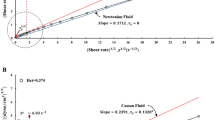Summary
The effect of Streptokinase-infusion upon the flow properties of blood was investigated by viscometric and aggregometric methods. Under fibrinolytic therapy, we found in all cases a significant fall in fibrinogen content, as well as a strong reduction in plasma viscosity, velocity of red cell aggregate formation and shear resistance of red cell aggregates. In addition, a drop in apparent blood viscosity at all shear rates was found. In no case, a total desaggregation of red cell was noted.
The hematocrit value remained practically constant; consequently, the drop in apparent blood viscosity at high (160 s−1) shear rates and intermediate (8 s−1) shear rates can be solely accounted for by the observed drop in plasma viscosity. At low shear rates (2.3 s−1) the observed drop in apparent viscosity is partly caused by aggregation desaggregation, but mainly by a drop in plasma viscosity.
The presented results again confirm that the method of rotational viscometry only incompletely records the improvement in the flow properties of blood that are caused by a therapy aimed at a reduction of the plasma fibrinogen content.
Zusammenfassung
Der Effekt einer Streptokinaseinfusion auf die Fließeigenschaften des Blutes wurde mit viskosimetrischen und aggregometrischen Methoden untersucht. In allen Fällen fand sich unter der Streptokinasebehandlung ein starker Abfall des Fibrinogenspiegels, starke Abnahme der Plasmaviskosität, der Scherungsresistanz und Bildungsgeschwindigkeit von Erythrozytenaggregaten und (weniger ausgeprägt) eine Abnahme der scheinbaren Blutviskosität bei allen Schergraden. In keinem Falle wurde unter der Behandlung eine völlige Aufhebung der Erythrozytenaggregation gesehen.
Bei nahezu konstantem Hämatokritwert ist die Abnahme der scheinbaren Blutviskosität bei mittleren (8 s−1) und hohen Schergraden (160 s−1) allein durch die Abnahme der Plasmaviskosität ausgelöst, bei niedrigen Schergraden (2.3 s−1) vorwiegend durch Abnahme der Plasmaviskosität.
Die vorliegenden Untersuchungen haben erneut bestätigt, daß die Methode der Rotationsviskosimetrie, die durch defibrinogenisierende Maßnahmen ausgelöste Verbesserung der Fließfähigkeit des Blutes nur unvollständig erfaßt.
Similar content being viewed by others
Literatur
Appelgren, L., Gustavsson, L., Myrvold, H.: Flow improvement by defibrinogenation (DF). Abstr. 1st World Congr. Microcirculat, Toronto 1975
Benda, L.: Streptokinase und Blutviskosität beim akuten Herzinfarkt. In: Aktuelle Probleme der Fibrinolysebehandlung, S. Sailer (Ed.) Wien (Hollinek) 27–33 (1973)
Berman, H.J.: Rheological properties of the microvasculature. Bibl. anat.7, 29–34 (1965)
Chien, S.: Shear dependence of effective cell volume as a determinant of blood viscosity. Science168, 977–979 (1970)
Clauss, A.: Gerinnungsphysiologische Schnellmethode zur Bestimmung des Fibrinogens. Acta haemat. (Basel)17, 237 (1957)
Ehrly, A.M., Lange, B.: Reduction in blood viscosity and disaggregation of erythrocyte aggregate by streptokinase. In: Theoretical and Clinical Hemorheology, H.H. Hartert and L.A. Copley (Eds.) Springer Berlin, Heidelberg, New York 366–374 (1971)
Ehrly, A.M.: Verbesserung der Fließeigenschaften des Blutes: Ein neues Prinzip zur medikamentösen Therapie chronisch arterieller Durchblutungsstörungen. VASA, Suppl. Nr. 1 (1973)
Ehrly, A.M., Köhler, H.-J., Schroeder, W., Müller, R.: Sauerstoffdruckwerte im ischämischen Muskelgewebe von Patienten mit chronischen peripheren arteriellen Verschlußkrankheiten. Klin. Wschr.53, 687–688 (1975)
Heinrich, F. (Ed.): Streptokinase Therapie bei chronischer arterieller Verschlußkrankheit — Ergebnisse einer multizentrischen Studie, Med. Verlagsgesellschaft Marburg/Lahn 1975
Klose, H.J., Volger, E., Brechtelsbauer, H., Heinich, L., Schmid-Schönbein, H.: Microrheology and light transmission of blood. I. The photometric quantification of red cell aggregation and red cell orientation. Pflüger's Arch.333, 126–129 (1972)
Martin, M., Schoop, W., Zeitler, E.: Thrombolyse bei chronischer Arteriopathie. In: Aktuelle Probleme der Angiologie Bd. 8, Bern-Stuttgart-Wien (Huber) 1970
Schmid-Schönbein, H., Klose, H.J., Volger, E.: Effect of colloidal plasma substitutes on microrheology of human blood. In: Hemodilution: Theoretical basis and clinical application. K. Messmer and H. Schmid-Schönbein (Eds.), Karger, Basel-New York 1972a, p. 66–83
Schmid-Schönbein, H., Volger, E., Klose, H.J.: Microrheology and light transmission of blood. II. The photometric quantification of red cell aggregate formation and dispersion in flow. Pflüger's Arch.333, 140–155 (1972b)
Schmid-Schönbein, H., Von Gosen, J., Heinich, L., Klose, H.J., Vogler, E.: A counter-rotating “rheoscope chamber” for the study of the microrheology of blood cell aggregation by microscopic observation and microphotometry. Microvasc. Res.6, 366–376 (1973a)
Schmid-Schönbein, H., Heinich, L.: A simple device allowing blood viscometry at low rates of shear with the Wells-Brook-field-Viscometer. Res. Exp. Med.161, 49–57 (1973b)
Schmid-Schönbein, H., Gallasch, G., Volger, E., Klose, H.J.: Microrheology and protein chemistry of pathological red cell aggregation (Blood sludge) studied in vitro. Biorheology10, 213–227 (1973c)
Schmid-Schönbein, H., Kline, K.A., Heinich, L., Volger, E., Fischer, T.: Microrheology and light transmission of blood, II. The velocity of red cell aggregate formation. Pflüger's Arch.354, 299–317 (1975)
Schmid-Schönbein, H., Gallasch, G., Von Gosen, J., Volger, E., Klose, H.J.: Red cell aggregation in blood flow. I. New methods of quantification. Klin. Wschr.54, 149–157 (1976)
Schmid-Schönbein, H., Gallasch, G., Von Gosen, J., Volger, E., Klose, H.J.: Red cell aggregation in blood flow. II. Effect on apparent viscosity of blood. Klin. Wschr.54, 159–167 (1976)
Volger, E., Schmid-Schönbein, H., Von Gosen, J., Klose, H.J., Kline, K.A.: Microrheology and light transmission of blood, IV. The kinetics of artificial red cell aggregation induced by dextran. Pflüger's Arch.354, 219–337 (1975)
Wells, R.E., Schmid-Schönbein, H., Goldstone, J.: Flow behavior of red cells in pathologic sera: Existence of a yield shear stress in the absence of fibrinogen. In: Clinical and theoretical hemorheology, H. Hartert and A.L. Copley (Eds.) Heidelberg-New York (Springer, Verlag) 1971, p. 358–365
Author information
Authors and Affiliations
Rights and permissions
About this article
Cite this article
Schmid-Schönbein, H., Rieger, H. & Hess, H. Quantitative Erfassung der Effekte fibrinolytischer Therapie auf das Fließverhalten des Blutes. Klin Wochenschr 55, 111–119 (1977). https://doi.org/10.1007/BF01490238
Issue Date:
DOI: https://doi.org/10.1007/BF01490238
Key words
- Blood rheology
- Non-Newtonian viscosity
- Plasma viscosity
- Red cell aggregation
- Rouleaux formation
- Photometric aggregometry
- Streptokinase therapy




